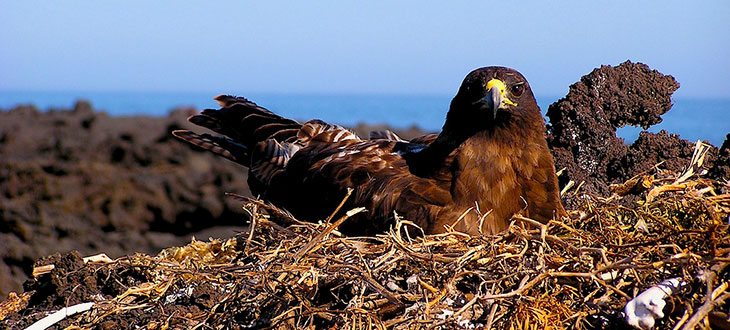No Bird Is An Island, Unless You're A Louse

Noah Whiteman, University of Arizona
(Inside Science) -- In Darwin's classic example of evolution, one founding group of birds evolved into fifteen different finch species in the Galápagos Islands by adapting to different conditions on each island. But if you're a parasite, you don't need an island -- just one bird will do.
Evolutionary biologists have long speculated that parasites diverge into different species at the same time that their hosts do, but it's hard to observe this happening. A new study in Darwin's old stomping grounds finds that Galápagos hawk populations form distinct genetic groups on each island. But, the genes of the lice that latch on to the hawk track more closely to the genes of the hawk than to which island they inhabit.
"Many individuals, whether they're birds or mammals, can probably act as islands for their parasite populations," said David Reed, an evolutionary biologist at the University of Florida in Gainesville, who was not involved in the research. He said that the study uncovers an additional layer of information: lice form genetically-different populations, not just on islands, but on each bird.
Though most people revile parasites such as lice, ticks and bedbugs, parasitism is a surprisingly popular way for animals to make a living.
"Most species of life on Earth, in terms of animals, are parasites," said Noah Whiteman, an ecological geneticist at the University of Arizona in Tucson. "This is one mechanism that might have generated that diversity."
Whiteman's study, which appeared in the journal Biology Letters, stems from his work as a graduate student in the lab of co-author Patricia Parker, a zoologist, at the University of Missouri, St. Louis.
The researchers examined the genetic makeup of Galápagos hawks and one of their parasites, the feather louse, which both live on eight islands in the Pacific Ocean. About 125,000 years ago, the ancestor of the Galápagos hawk split off from the Swainson's hawk when it colonized the Galápagos Islands, likely carrying its lice along with it. Since then, the hawks -- and their lice -- have been diverging and may one day become different species on each island, just like Darwin's finches.
The feather louse clings to the hawk's feathers, nibbling away, and usually passes from mother to young in the nest. Because only a few lice move to a given baby chick, all of that chick's lice in the following generations are very similar and highly inbred. While the hawks are estimated to live about two decades, the lice go through 12 generations each year. Even mated hawks can have louse populations with very different genetics, showing that the lice rarely move from one hawk to another to interbreed. This type of reproductive isolation -- where each bird serves as an island for its parasites -- creates the perfect environment for organisms to diverge into new species.
The researchers collected blood samples and lice from hawks on each island. They used a method called "dust ruffling" where they ruffled the birds' feathers over a cafeteria tray and then placed the lice that fell off in alcohol to preserve their DNA. Back in the lab, they sequenced segments of DNA to construct genetic fingerprints for each bird and louse.
By comparing differences in their DNA, researchers found that the hawk populations were genetically distinct on each island. Though the lice also showed differences between the islands, the genetics of the lice could be best predicted by which hawk hosted them.
In the future experiments, Whiteman would like to sequence entire genomes from lice collected from individual birds, to see just how different these populations on different birds can be, though he has no immediate plans to return to the Galápagos.
Researchers are seeing these same trends in a variety of host-parasite relationships. All animals, including humans, lions, and even dinosaurs have carried their own specific species of lice for the duration of their evolution. Reed said that he and fellow scientists are "scratching our heads" to understand how lice can continue to survive and spread despite their highly inbred populations.
"Parasites often behave very differently than the way that we expect them to based on the population genetics of free-living organisms," said Reed.
The close relationship between the hawks and their lice make Whiteman question whether these parasites might play some vital role in the evolution of these endangered birds. He gives the example of the California condor, which was deloused by wildlife officials when the few remaining birds were taken into captivity in the 1980s. Though the condor has survived, its feather lice species is now extinct. Scientists will never know how the lice contributed to the condor's evolution, or what the parasite might have revealed about the bird's history.
"Do these parasites help make the Galápagos hawk what it is?" asked Whiteman. "Maybe they've helped shaped some of the most beautiful creatures that humans appreciate."
Patricia Waldron (@patriciawaldron) is a news intern at Inside Science.
*A previous version of this story listed the wrong journal title. The new research ran in Biology Letters. We regret the error.
